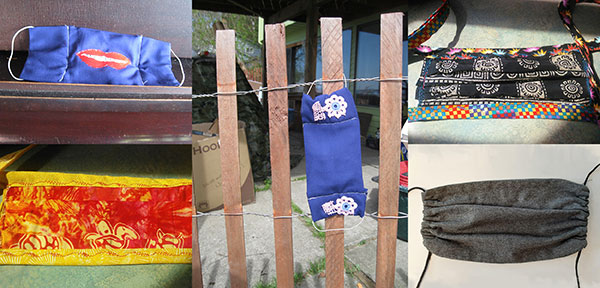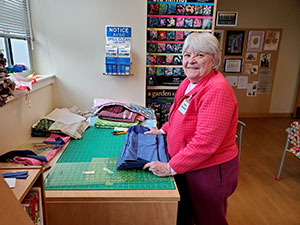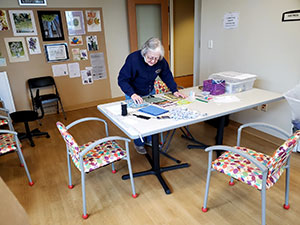What’s the Skinny on COVID-19 Face Masks?

Maybe you’ve heard the coronavirus face mask joke that’s been circulating: “I never thought I would see the day when I would don a mask, walk up to a bank teller, and demand money!”
For several months, a lot of information about face masks has circulated and now face marks are commonly worn by people who have to leave their homes. Initially, we heard that only people who were sick should wear masks (and also health care workers). More recently, everyone has been advised to wear a face mask if they might encounter a situation where physical distancing (six feet or more) would be impossible to maintain. In some parts of the country, face masks are required by law when someone goes out in public while the pandemic is active. They are not required here at this time.
Follow these links to find out what public health experts say:
- Public Health—Seattle & King County—Staying apart from other people is our best protection against COVID-19, but masks can be a supplement.
- Washington State Department of Health—When you cannot maintain six feet of distance from others in public (e.g., grocery store, pharmacy, hardware store, health clinic), wear a cloth face covering. There is no mandate that you must wear a face covering; however, a face covering can provide an additional layer of protection.
- Centers for Disease Control and Prevention—A simple cloth face covering may slow the spread of the coronavirus and help prevent people who may have the virus and do not know it from transmitting it to others. Homemade cloth face coverings can be used as an additional, voluntary public health measure.
Because there is a shortage of medical masks, they should be reserved for frontline healthcare providers.
Public health experts agree that homemade fabric masks and other non-medical masks do NOT replace the need to stay home and limit contact with others, with a minimum of six feet of distance when it’s impossible to avoid the public. A mask does not replace frequent handwashing with soap and water. And everyone should continue to avoid touching their face and stay away from anyone who is ill.
Putting your mask on and taking it off

Skyline resident Irene Campbell prepares fabric for face coverings.
To be effective, masks should be worn consistently in public. They should not be put on and taken off frequently.
Before putting a face mask on, wash your hands or use hand sanitizer. Be sure your mask covers your entire nose and mouth. Do not take it off and put it back on. Masks that have been worn may be contaminated. Wash your hands again after removing a mask. Fabric masks should be changed when moist and washed after each use.
Making your own mask—whether or not you can sew
Fabric masks can help prevent the spread of infection to others when they are worn by people who are already infected with the virus that causes COVID-19. Many people who carry the virus do not show symptoms right away. A mask can help block infectious droplets from spreading when someone coughs, sneezes, or speaks.

Skyline resident Mary Whitmore sorts through patterned fabrics that will become face masks.
There are lots of ways to make a cloth mask, and they can be creative. The photos at the top of this page are masks sewn by several members of the Seattle-King County Advisory Council on Aging & Disability Services, including Joe Hailey, June Michel, Sue Weston, and Barb Williams. All serve on the Advisory Council’s Advocacy Committee. They jumped into action when they learned masks were recommended.
The photo in the center of the collage shows a mask hanging on a fence—Sue Weston left it there for one of her Vashon Island neighbors. Cloth masks are often available at a roadside flower stand on the island, too.
Joe made the gray mask pictured above, using an old t-shirt and shoelaces.
Barb’s neighbors at the Skyline retirement community on Seattle’s First Hill set up a sewing room for mask-making. See photos above.
Do you sew? Great! The Centers for Disease Control and Prevention published an easy tutorial with instructions for sewing a face covering using two pieces of cotton fabric (each 10″x6″) and two 6″ pieces of elastic (or rubber bands, string, cloth strips, hair ties).
You don’t sew? Not a problem! The same tutorial includes two (2) methods of creating a face covering without sewing—one requiring only a t-shirt and scissors, and the other using a bandana and rubber bands or hair ties. As Joe learned, shoelaces work well, too.
To download the CDC instructions, click here. Prefer video tutorials? Visit YouTube and search for DIY face masks, and enjoy this CDC video of the U.S. Surgeon General, Dr. Jerome Adams, making his own no-sew mask in only 46 seconds.
Contributor Irene Stewart manages communications for Aging and Disability Services and serves as editor of AgeWise King County.
![AgeWise King County [logo]](https://www.agewisekingcounty.org/wp-content/themes/agewisekingcounty/images/logo.png)